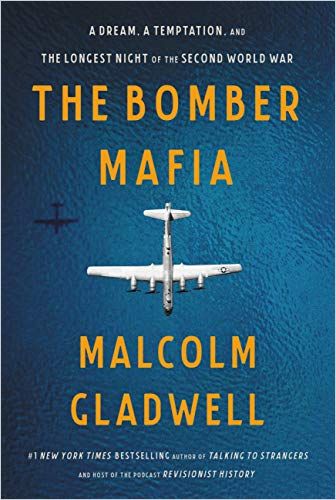Best-selling public intellectual Malcolm Gladwell offers a detailed history of the United States’ bombing tactics in World War II.

Death from Above
In a departure from the social psychology themes of his earlier books – The Tipping Point, Blink and Outliers, among them – New Yorker staff writer Malcolm Gladwell pursues a personal interest, one that only dedicated war buffs will likely share.
He introduces a cadre of Army Air Corps visionaries – dubbed the Bomber Mafia – who shared a dream: fleets of precision bombers leveling factories and destroying the enemy’s ability to fight. They believed this strategy would spare millions of lives. While more brutal tactics – like those of massive bombing strategist Curtis LeMay – prevailed, the Bomber Mafia spirit lives on in Gladwell’s prose.
You cannot understand how the three main branches of the American military behave and make decisions unless you understand how different their cultures are.Malcolm Gladwell
This New York Times Book Review Editor’s Choice garnered the usual effusive praise that greets Gladwell’s efforts. Kirkus Reviews called it, “Excellent revisionist history… another Gladwell everything-you-thought-you-knew-was-wrong page-turner.” The Sunday Times (UK) found it, a “brilliantly told parable.” Publishers Weekly said, “… fans will savor the insights into ‘how technology slips away from its intended path’.”
Army Air Corps
Originally, Gladwell explains, the US Air Force was the Army Air Corps. The Army used combat aircraft for reconnaissance and dogfighting and, the author notes, it suffered more casualties from accidents than from bullets.
The Army didn’t construct a proper air training base until the 1930s, Gladwell says, when it built the Air Corps Tactical School in a remote location: Maxwell Field in Montgomery, Alabama.
Gladwell paints the Alabama training grounds as an academy, but because air combat was so new, the faculty didn’t know much. In one of the most compelling sections of the book, the author details how US air warfare strategy, tactics and values emerged mostly from late-night talk sessions.
They mostly made things up – on the fly, so to speak.Malcolm Gladwell
The flyers at the Maxwell Field faculty – the Bomber Mafia – believed, Gladwell reveals, that precision destruction would cripple the enemy and make it give up, sparing millions of soldiers and civilians.
Gladwell shows an unlikely fascination with the Air Corps plan, which required hundreds of Mark XVs, computerized bombsights developed by Carl Norden, who promised it could drop a bomb into a barrel from an airplane traveling 30,000 feet up at hundreds of miles per hour.This vision was a military dream: if bombers could realize that degree of precision, they could wage war with such exactness that “we wouldn’t need armies anymore.”
Gladwell points out that Prime Minister Winston Churchill and his advisers believed that mass, indiscriminate night bombing would bring about a quick surrender. The Bomber Mafia, Gladwell stresses, had a different point of view; they saw precision bombing as a more humane path. They hoped that by knocking out crucial enemy manufacturing facilities, they could bring the war to a halt.
Ball Bearings
Bomber Mafia member Haywood Hansell, whom Gladwell depicts as a precision bombing zealot, sought to bomb ball-bearing factories. Gladwell spends an inordinate amount of ink explaining how bomber pilots attacking from England, once led by the iron-willed Colonel Curtis Lemay, failed to coordinate their strikes and suffered terrible causalities.
This debacle, he reveals, taught the Air Corps that, alas, the Norden bombsights were useless; only 80 out of 2,000 bombs hit the factories. After that, Gladwell says, indiscriminate night bombing became the norm. The bombsight did not live up to its lab reports or training films.
The year 1943 was a dark time for the Bomber Mafia. Every one of its ideas crumbled in the face of reality.Malcolm Gladwell
In Dresden, for example, Gladwell discloses that more than 25,000 civilians died in three nights of bombing – depicted, as aficionados know, in Kurt Vonnegut’s Slaughterhouse Five.
Firebombs
Gladwell relates how napalm – a gel-like substance that sticks to targets and keeps burning – was developed to attack crowded Japanese cities made of paper and wood houses.
By early 1945, Hansell had storehoused tons of incendiary bombs, yet, Gladwell points out with admiration, the Air Force officer could not bring himself to firebomb civilians. The Air Force, Gladwell laments, dismissed Hansell and gave LeMay his command.
The more you invest in a set of beliefs – the greater the sacrifice you make in the service of that conviction – the more resistant you will be to evidence that suggests that you are mistaken.Malcolm Gladwell
Gladwell depicts LeMay as being in alignment with the military brass and – and after FDR’s death – with President Harry Truman. They all wanted to end the war quickly. Gladwell offers the astonishing estimates that an invasion of Japan could have led to half a million dead Americans and as many Japanese.
Instead of an invasion, on March 9, 1945, Allied B-29 bombers swarmed over Tokyo, likely killing 100,000 people. Gladwell, who describes LeMay’s plans for firebombing Japan as being based on massive, low-flying nighttime attacks with no particular accuracy, sites this as the most deadly toll in a single day of war in human history, before or since. Bombers destroyed city after city; more Japanese perished than in the nuclear attacks on Hiroshima and Nagasaki. Japan capitulated in August 1945.
Gladwell argues that history might forgive and even celebrate LeMay and Truman for ending the war in 1945, but he makes no mention of how LeMay’s outdated, callous tactics in the Vietnam War raised numerous controversies and proved wholly ineffective.
Gladwell believes that for courage, integrity and commitment to a more humane path, history will honor Haywood Hansell and the Bomber Mafia.
Moral Questions
Malcolm Gladwell’s approach here seems a shade hurried and perhaps less freshly insightful than his usual work, however, it appeals directly to fans of his Revisionist History podcasts. He doesn’t delve very deeply into the moral questions he raises, though clearly he supports his bombers’ tactical hopes of ending the war more quickly and efficiently.
You wage war as ferociously and brutally as possible, and in return, you get a shorter warMalcolm Gladwell
Gladwell takes on an oddly gee-whiz tone in describing apocalyptic destruction, caught perhaps between the greater heft of his other works and the mostly story-telling nature of this one – a narrative treat primarily for his fans and war history aficionados.
Malcolm Gladwell’s bestsellers include The Tipping Point; Blink; Outliers; Talking to Strangers; David and Goliath; and What the Dog Saw.







